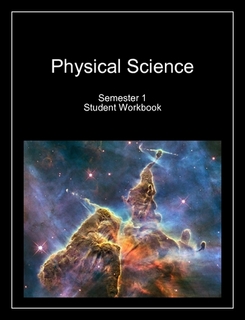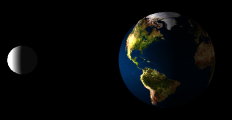|
|
Physical Science

|
|
|
|
Description
This course is a Physical Science course with lab exercises. This course is typically taken in 8th or 9th grade, and is usually the last science course before the high school sciences (physics, chemistry, and biology). At some schools this course is referred to as an Intro to Physics and Chemistry, although it also include some astronomy and earth science. If taken in 9th grade, schools would typically count this course as a high school science credit.
|
Lecture Notes and Class Time
When this class is taught live, class time is primarily spent on instruction. Students bring their Student Workbook to each class, or a printout of the pages for that week. The pages of the workbook are identical to the instructor's lecture notes, except the student version has the solutions and answers deleted. During the lecture the students take notes and solve the example problems in the workbook.
Videos of the lectures are also available online, and these videos go through the same lecture notes, point by point. Students use the videos to cover any material that time constraints did not permit us to cover in our weekly class. Or, if a student misses a class or needs to review the material, all of the course content is available online. Distance leaners take the entire class online, but receive the exact same course content as they would in a live class.
|
Textbook
The complete content of this course is in the lecture notes and videos of the lectures,
in the Student Workbook, and in the supplemental readings. Separate textbooks are no longer necessary.
Originally written for a group of students in California, this course was based on the California text Focus on Physical Science
and also on Paul Hewitt's Conceptual Physical Science.
|
Homework, Tests and Grades
Students will be given specific assignments to complete each week. Assignments will consist of Practice Problems from the workbook, instructional videos online, and written assignments.
In this class there is a distinction between Practice Problems and Homework Problems. Practice Problems are found in the workbook, and students check their answers with the solutions provided. Homework assignments and tests are printed from the website, completed, and turned in for a grade.
To maximize instructional time in class, tests will be given at home. One final exam for each semester will be taken in class at the end of each semester. Students will receive a numerical grade for each semester and for the year. The grade is calculated based on tests, graded homework and the final exams.
|
Internet Access
Access to a computer with a high speed internet connection is strongly recommended. Instructional materials such as lecture videos, lecture notes, homework assignments and tests will be available over the internet. Graded assignments and tests may also be returned via email in order to provide more timely feedback. Progress reports will be put on the website and updated regularly.
|
The Instructor
Derek Owens graduated from Duke University in 1988 with a degree in mechanical engineering and
physics. He taught physics, honors physics, AP Physics, and AP computer science at The Westminster Schools
in Atlanta, GA from 1988-2000. He worked at the TIP program at Duke for two years, teaching physics and
heading the Satellite Science Program. He received a National Science Foundation scholarship and
studied history and philosophy of science at L'Abri Fellowship in England. He worked as a software
developer for six years before returning to teaching. Since 2006, he has been a full time teacher for
homeschoolers in the Atlanta area. He and his wife Amor and their two children Claire and David
attend Dunwoody Community Church, a non-denominational church near their home in Norcross, GA.
|
Course Outline
Physical Science
-
Chapter 1: Motion
Historical matter, Position, Velocity, Acceleration, Units, Reference Frames, Graphing Motion, Converting Units, Vectors
-
Chapter 2: Force
Forces, Mass and Inertia, Aristotle, Galileo, Newton, Newton`s Laws of Motion, Net Force, Motion and Force in Two Dimensions, Friction, Gravity, Orbits
-
Chapter 3: Fluids
Pressure, Units for Pressure, Blaise Pascal, Fluid Pressure, Atmospheric Pressure, Transmitting Pressure in Fluids, Buoyancy, Floating and Sinking, Bernoulli`s Principle
-
Chapter 4: Simple Machines
Archimedes, Levers, Types of Levers, Mechanical Advantage, Inclines, Wheel and Axle, Pulleys, Gears, Work and Efficiency
-
Chapter 5: Temperature and Heat
Celsius, Fahrenheit, Kelvin, Heat, Heat Capacity, Thermal Expansion, Heat Transfer, Convection, Conduction, Radiation, Light Waves, Change of Phase, Evaporation, Condensation
-
Chapter 6: Electricity and Magnetism
Electric Charge, Electric Current, Voltage, Direct Current and Alternating Current, Ohm`s Law, Series and Parallel Circuits, Magnets, Oersted`s Experiment, Magnetic Domains, Magnetic Fields, The Motor Effect, The Generator Effect
-
Chapter 7: Atoms
The Elements, The Periodic Table, Isotopes, The Nature of Light, Historical theories on light, The Quantum Hypotheses, Radioactivity, Rutherford`s Experiments, Nuclear Fission, Nuclear Fusion, The Manhatten Project
-
Chapter 8: Atomic Bonds and Chemical Reactions
Physical and Chemical Changes, Chemical Equations, Balancing simple chemical equations, Covalent Bonds, Ionic Bonds, Organic Compounds, Polymers
-
Chapter 9: The Earth, Moon, and Sun
Early Astronomy, The Earth-Moon-Sun System, Rotation and Revolution, Solstices and Equinoxes, Phases of the moon, Tides, Structure of the Moon, The Apollo Missions
-
Chapter 10: The Solar System
Historical look at the solar system, Ptolemy, Galileo, Brahe, Kepler, Newton, The Sun, The Inner Solar System, Meteors, The Outer Solar System
-
Chapter 11: Stars and Galaxies
Telescopes, Radio Telescopes, Astronomical Distances, The Big Bang Theory, Stars, The Life of a Star, Galaxies
|
|
|
|
